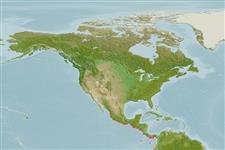Common names from other countries
Environment: milieu / climate zone / depth range / distribution range
Ecologia
marinhas demersal; intervalo de profundidade 0 - 8 m (Ref. 57883). Tropical
Eastern Pacific: Mexico and El Salvador.
Tamanho / Peso / Idade
Maturity: Lm ? range ? - ? cm
Max length : 6.1 cm SL macho/indeterminado; (Ref. 57883)
Descrição breve
Chaves de identificação | Morfologia | Morfometria
Raios dorsais moles (total) : 64 - 72; Raios anais moles: 49 - 54; Vértebras: 39 - 41. The species is distinguished by the following characters: vertebrae 11 + 28-30 = 39-41, dorsal fin rays 64-72, anal fin rays 49-54; outer pseudoclasper is broad, wingshaped with single curved supporter; inner pseudoclasper with three lobes, consisting of a branched supporter, anterior branch curved and long, posterior branch short, and a thick fleshy lobe in between;
penis with no abrupt change in thickness; opercular spine with single, sharp tip in small specimens and bi- or tri-furcated in specimens > 45 mm SL; scale patch on cheeks is broad, with 8-10 vertical scale rows; otolith length: height ratio 2.2 (Ref. 57883).
Apparently lives on rocky bottoms (Ref. 57883).
Life cycle and mating behavior
Maturities | Reprodução | Spawnings | Egg(s) | Fecundities | Larvas
Møller, P.R., W. Schwarzhans and J.G. Nielsen, 2005. Review of the American Dinematichthyini (Teleostei: Bythitidae). Part II. Ogilbia. aqua, J. Ichthyol. Aquat. Biol. 10(4):133-207. (Ref. 57883)
Categoria na Lista Vermelha da IUCN (Ref. 130435)
CITES (Ref. 128078)
Not Evaluated
Ameaça para o homem
Harmless
Utilização humana
Ferramentas
Relatórios especiais
Descarregue XML
Fontes da internet
Estimates based on models
Preferred temperature (Ref.
115969): 24.3 - 29.1, mean 26.9 (based on 190 cells).
Phylogenetic diversity index (Ref.
82804): PD
50 = 0.5000 [Uniqueness, from 0.5 = low to 2.0 = high].
Bayesian length-weight: a=0.00389 (0.00180 - 0.00842), b=3.12 (2.94 - 3.30), in cm Total Length, based on all LWR estimates for this body shape (Ref.
93245).
Nível Trófico (Ref.
69278): 3.3 ±0.5 se; based on size and trophs of closest relatives
Fishing Vulnerability (Ref.
59153): Low vulnerability (10 of 100).
